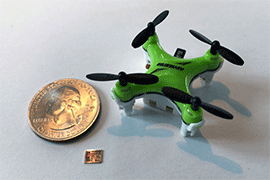Last year, new research resulted in a tiny chip specially designed to fit in and power bee-sized drones. This year, the size of the chip was reduced even more along with its consumption of power. Here Navion placed next to a quarter and a small drone for perspective.
MIT’s Department of Electrical Engineering and Computer Science and the Department of Aeronautics and Astronautics joined forces to create a micro-chip that will help run efficiently the mini size drones the team has come up with some time last year. Under the leadership of both Vivienne Sze from the Department of Electrical Engineering and Sertac Karaman from the Department of Aeronautics, the research team was able to reduce the size of the chip a bit more so that it does not consume as much power; yet is more powerful.
 Introduced at the Symposia on VLSI Technology and Circuits earlier in the month of June, Navion, the new chip, has an area of 20 square millimeters and is runs on 24 milliwatts of energy. To put in perspective, the power needed to light up one lightbulb can power 1000 Navion chips. However, despite its minuscule size, Navion can process 171 images per second. Researchers plan to use the chip to activate and operate drones so small they could fit on top of a fingernail, on territories where the GPS doesn’t work. Other applications of Navion include running small electronic devices over a long period of time on little energy, or medical micro devices that navigate inside the human body to find a problem.
Introduced at the Symposia on VLSI Technology and Circuits earlier in the month of June, Navion, the new chip, has an area of 20 square millimeters and is runs on 24 milliwatts of energy. To put in perspective, the power needed to light up one lightbulb can power 1000 Navion chips. However, despite its minuscule size, Navion can process 171 images per second. Researchers plan to use the chip to activate and operate drones so small they could fit on top of a fingernail, on territories where the GPS doesn’t work. Other applications of Navion include running small electronic devices over a long period of time on little energy, or medical micro devices that navigate inside the human body to find a problem.
Usually, drones use most of their battery to fly, and the remaining energy to perform their assigned tasks. It helped that the hardware of energy was separate from the software. With the bee-sized drones, both hardware and software had to be combined inside the operating chip. The first design of the chip was tested on field-programmable gate array, and the chip used on 2 watts of power to fly and map the state. Even though that was a feat in itself, the chip was still too heavy for a min drone. Hence the further reduction of its size. To achieve that, the research team had to come up with a new design for the chip instead of remodeling the existing one; which according to Sze offer them a lot of flexibility in the process.
In a nutshell, to save on power, the team had to control how many images the chip was storing and processing at any given moment. As the drone takes pictures, they are compacted. The amount of data computed also changed based on the degree of importance. All the improvements allow the team to create a chip that has only 0.8 megabytes of memory but could still collect data from various places. Sze explained that the chip is not more powerful; it is also more flexible and can adapt to each environment it explores, saving even more on energy and using only 24 milliwatts.
The next step now is to test the chip, and the researchers think that a miniature race car will be the right fit for Navion before the prototype is tested on an actual miniature drone. Given all the possible applications of Navion, it is no surprise that the U.S Air Force and the National Science Foundation are supporting the study.






